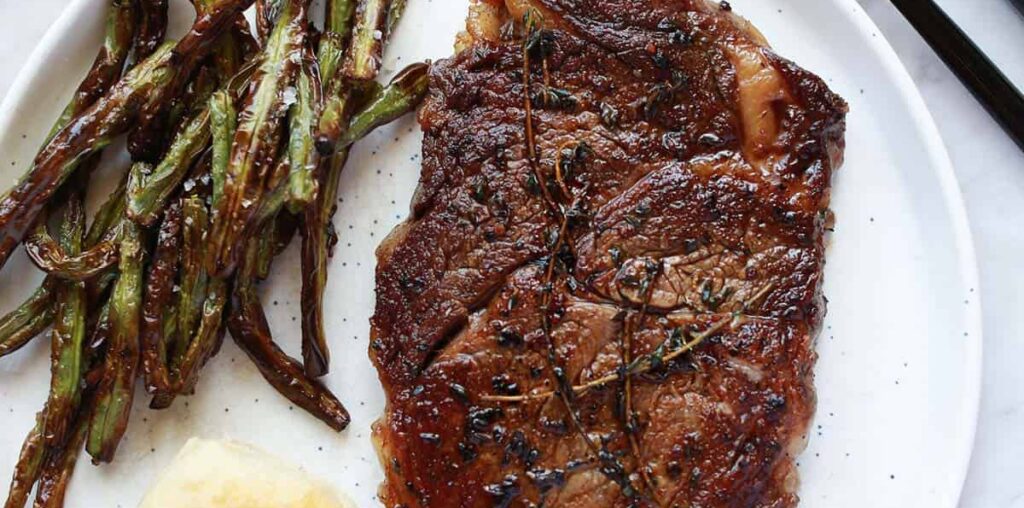Knowing to how to cook steak for your own stay home steakhouse experience is an invaluable skill. While making steak at home might sound intimidating, it’s actually a really easy and quick dinner you can whip up with lots of different side dish options. You can cook steak—I promise!
In this post, I’m going to share how to cook steak at home on the stovetop. You don’t need any special equipment, but I do recommend a cast iron skillet and reliable spatula or tongs.
Related: Next up, learn how to cook steak in the oven, aka how to broil steak. And how to make air fryer steak.


Seasoning Options
- Salt – sea salt, Himalayan pink salt, Celtic salt or table salt is OK too
- Black pepper
- Seasoning mix – I use one called “Pappy’s” that we like on all sorts of meats, but any seasoning mix you like can work well. This is a personal preference and if you aren’t sure just stick with salt and pepper
- Butter – or garlic butter/other savory compound butters
- Garlic
- Thyme – or other fresh herbs like rosemary


How to Cook Steak
First, set the meat out so it comes to room temperate. I usually set it out on the counter about 30 minutes before I’m ready to cook.
Pat the steak dry on both sides and then generously season both sides with salt, pepper and any other seasoning mix you might be using.
Get your skillet very hot. Add a few teaspoons of cooking oil, I usually use something plain like canola oil or vegetable oil. Add the meat to the pan and let it sear and continue to cook for 2 minutes. Then flip the meat over in the pan and let it continue to cook for another 2 minutes. During this time add a tablespoon of butter, a clove of garlic, and the thyme (or other fresh herbs) to the pan. As soon as the butter melts spoon it over the meat as it cooks.
Check the internal temperature of the steak for the doneness level you are looking for. Keep in mind the temperature will continue to rise a little even after you remove it from the pan.
Once done remove to aluminum foil and cover. Allow the steak to rest for 5-8 minutes. This really is critical, don’t immediately cut into the cooked steak.


Types of Steak
Sometimes this is also called cuts of steak.
- Ribeye: Known for its marbling and rich flavor.
- T-bone: A combination of the tenderloin and strip steak, with a T-shaped bone in the center.
- Porterhouse: Similar to the T-bone but with a larger portion of tenderloin.
- Filet Mignon: A tender cut from the tenderloin, very lean with a buttery texture. This also tends to be a thicker cut so good for those who prefer their steak less done.
- New York Strip: Known for its balance of tenderness and flavor, typically well-marbled.
- Sirloin: A versatile cut that’s flavorful but less tender than premium cuts.
- Flank Steak: A lean, fibrous cut often marinated and grilled or sliced for fajitas.
- Skirt Steak: A flavorful cut from the diaphragm, great for grilling and stir-frying.
- Flat Iron: A well-marbled cut from the shoulder, known for its tenderness and flavor.
- Chuck Eye: A budget-friendly cut that’s flavorful and tender, often used for grilling.
- Hanger Steak: Known for its rich flavor, often used in bistro-style dishes.
- Brisket: Typically slow-cooked or smoked, known for its rich flavor.
- Tri-Tip: A triangular cut from the bottom sirloin, popular for roasting and grilling.
At our house, I will usually use this method of cooking steak for Ribeye, T-bone and Filet. Those are the types I most commonly buy unless I am making something else like pot roast, stew or fajitas.
When shopping at a meat counter, if you are unsure what type you need, just describe what you are making or the cooking method you plan. And let’s say you know you want a filet, if they ask you which one you want (like you are looking at a display counter and there are multiple to choose from) if you feel unsure ask them which one(s) they would buy. 🙂


What to Serve with Steak
We will usually serve this with a vegetable side dish and maybe a carbohydrate too (like rice, noodles, or potatoes).
Frequently Asked Questions
Why do you want steak to be at room temperature before cooking?
This helps the steak to cook more evenly.
Why do you need to let steak rest after cooking?
Resting allows the juices throughout the meat to redistribute, resulting in a more tender and juicy steak when you cut into it.
Why do you pat steak dry before cooking?
Patting your steak dry before seasoning will give it a deep brown, flavorful crust. This move prevents the salt from melting and stops steam from forming when the steak hits the pan—both important for a good sear.


Temperatures of Doneness
- Rare: 120–125°F (49–52°C)
- Medium Rare: 130–135°F (54–57°C)
- Medium: 140–145°F (60–63°C)
- Medium Well: 150–155°F (65–68°C)
- Well Done: 160°F (71°C) and above
Personally, I tend to aim for 135°F before I remove the steak from the pan. Then the temperature tends to rise a little more after cooking, so I end up with a medium steak. I always use a meat thermometer and I do recommend this if you are new to cooking steak as it’s difficult to guess based on looking at the outside, especially when different cuts of meat will have different thickness levels and this will affect how long they need to cook.


How to Store & Leftover Ideas
- Store raw steak in the refrigerator for 3-5 days. If you plan to store it longer than this, I would freeze it.
- You can store (cooked) leftovers in an airtight container in the refrigerator for 3-4 days.
- Leftovers can be used so many ways! Cut it up and add to salad, fajitas, nachos, a grilled cheese sandwich, a quesadilla, and so much more. And if you have dogs, like we do, they also would appreciate any leftovers.


Get our FREE recipe guide with our most popular recipes of all time!


Free Popular Recipe Guide
Our top 25 recipes of all time!
Get the Recipe
How to cook any cut of steak on the stove top in minutes
Instructions
-
First, set the steak out so it comes to room temperature. I usually set it out on the counter about 30 minutes before I’m ready to cook.
-
Pat the steak dry on both sides and then generously season both sides with salt, pepper and any other seasoning mix you might be using.
-
Get your skillet very hot. Add a few teaspoons of cooking oil.
-
Add the steak to the pan and let it sear and continue to cook for 2 minutes.
-
Then flip the steak over in the pan and let it continue to cook for another 2 minutes. During this time add the garlic butter, or butter and a clove of garlic, and the thyme (or other fresh herbs) to the pan. As soon as the butter melts, spoon it over the steak as it cooks.
-
Check the internal temperature of the steak for the doneness level you are looking for. Keep in mind the temperature will continue to rise a little even after you remove it from the pan.
-
Once done, remove to aluminum foil and cover. Allow the steak to rest for 5-8 minutes.
Notes
- Rare: 120–125°F (49–52°C)
- Medium Rare: 130–135°F (54–57°C)
- Medium: 140–145°F (60–63°C)
- Medium Well: 150–155°F (65–68°C)
- Well Done: 160°F (71°C) and above
Personally, I tend to aim for 135°F before I remove the steak from the pan. Then the temperature tends to rise a little more after cooking, so I end up with a medium steak. I always use a meat thermometer and I do recommend this if you are new to cooking steak as it’s difficult to guess based on looking at the outside, especially when different cuts of meat will have different thickness levels and this will affect how long they need to cook.
Nutrition
Nutrition Facts
How to Cook Steak
Amount per Serving
% Daily Value*
* Percent Daily Values are based on a 2000 calorie diet.
Notice: Nutrition is auto-calculated, using Spoonacular, for your convenience. Where relevant, we recommend using your own nutrition calculations.



